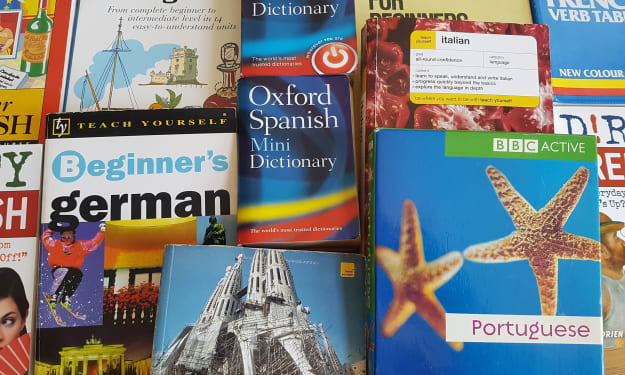Learn a Foreign Language at Home - Part Three
Immersing Yourself in the Language

When you read this, you probably think I’m going to tell you that you need to spend a significant amount of time in a country that speaks the language that you’re learning. Whilst that would be the perfect way to immerse yourself in the language, there are other ways to get the job done.
Listening, reading, and writing skills will be easier to develop than speaking with the ideas below. However, luckily for you, if you work on listening and reading first, you’ll have a larger vocabulary to speak (and write) with by the time you’re feeling ready for this.
Whilst you are listening and reading the language, over time your brain becomes accustomed to the sentence structures particular to that language and your ears tune in to the cadence of the words. Repetition of familiar words helps the pronunciation and meaning fall into place in your head.
Reading for Pleasure

Photo by Pixabay.com
Once you’ve learned the basics in the language an ideal way to practise and build on them is by reading. It’s important to make sure that you don’t demoralise yourself by either, (a) choosing something too difficult, or (b) expecting too much of yourself too soon.
To avoid these pitfalls I’d recommend two things, the first is to start reading with children’s books. Children’s books often have the aim of informing about a particular idea, emotion or event and therefore contain explanations; these are useful for the language learner who may not yet have acquired specific vocabulary but may know the words used to describe a term.
My second recommendation is to forget about understanding every word, at least initially. Your main aim is to read the story and enjoy the plot. So, don’t look up words unless they are key to helping you understand the plot. Otherwise reading becomes a tedious activity. You forget where you were because you’ve spent so long with your head in the dictionary and you have to keep rereading sections, soon the magic is lost and you’re simply trying to understand isolated fragments.
By all means, once you’ve read through once, go back and look up words. You’ll uncover extra meaning and depth to the story and this will add to the sense of achievement you feel when you get to the end of the book.
Once you feel confident with children’s books you could move on to some bigger children’s books, teen books and then adult/young adult novels.
How fast you move is up to you but remember, there is no race. The goal is to understand the key points, if you can’t do that then take a step back.
Streaming and DVDs

Photo by Pixabay.com
To give yourself practice at listening to the language you can stream foreign films, series and cartoons or buy the DVDs. I use Netflix and Amazon Prime to stream foreign programmes. I find the variety on Netflix the best and they are always adding new things.
An important note here, it’s not a test. Enjoy these programmes like you would a series in your mother tongue. Put the subtitles on in the beginning and don’t worry about how long you need them for; you are still learning.
Your ears are learning to distinguish the sounds of your new language at full speed and to pick out words in what seems (at first) to be one long jumble of sound. Soon you’ll pick out familiar words and before you know it, with the help of the subtitles you’ll be learning new ones too.
If you feel that you’d like a challenge and want to watch without the subtitles, I’d recommend starting with cartoons. They tend to be short, the images will help you understand the plot and children’s programmes are often explanatory by nature which is perfect when you are learning the language.
Don’t be tempted to pause and play back sections endlessly to hear every word, just as with the subtitles on, enjoy the programme. Don’t expect to understand everything, instead follow the story for the gist and don’t forget that your ears will need a minute or two to catch up with the speed of the speech. You can always watch it again with subtitles if you think you missed something.
Internet Radio
You can stream radio stations for some languages, I’ve done this for French and Spanish.
Songs are a great way to learn words and pronunciation. Radio presenters also speak at super high speed. Listen to the radio while you’re going about your business and you’re familiarising your ears and brain with the sounds and structures without putting in much effort at all.
Storycubes

Photo by Alicia Brunskill
I’ve recently begun using Storycubes and they are a fantastic tool. Once you feel like you have enough vocabulary to write something, try these. There are many ways to use them, here’s what I do.
I take three dice and roll them then I plan and write a story from the pictures that land face up. The length is up to you and your level of ability.
There are so many options here: you could challenge yourself and use only what you know in your head; you could use dictionaries etc. to get yourself using new words; if you’re learning with family/friends you could each write a line of the story in secret and see what you come up with; you could say the story out loud instead of writing… etc. I’m sure you can come up with more ideas.
Social Media and the News

Photo by Pixabay.com
It’s great if you know some people who speak the language you’re learning, you can practise with them here if they don’t live nearby. You can also listen to livestreams and podcasts or if the news is your thing you can stream it or read stories online.
Even if you don’t know people in the language you’re learning, you can get involved. I write micro-stories on Twitter in Spanish (stories in one tweet). I became involved by following Spanish writers and entering writing challenges, now some of the writers are my Twitter friends.
You don’t have to write stories though, find the people who share your interests in the language you're learning and talk with them about those!
Speaking Without a Speaking Partner
Finding opportunities to speak the language without being in its country of origin can be tough. If you can’t make trips to practise and you want to make progress, you have to push yourself a bit. And even if you can make trips, you can use these ideas.
First, use the speaking activities in the course you picked to learn the basics. Not just once, use them until you are confident and happy with your answers. If you’re using an app, don’t skip speaking!
Repeat words you hear in the programmes you’re watching or radio you’re listening to (in the target language). If you’re embarrassed do it when you’re on your own, but do it.
Sing songs in the language you’re learning – if you need the lyrics, use a search engine or YouTube to help.
When you’re out for a run, on the exercise bike, doing the washing up or some other repetitive activity, play this game. Start a conversation in your head in the language you’re learning, no dictionary allowed. Ask questions in the language and answer them as fully as you can. You can have your conversations out loud, but it might be best if you’re alone for that!
Another version of this game: you hear a question and either try to answer it in the language you’re learning or translate the question and then answer it. The idea is to try and use words you already know to give the best answer you can, as if you were really in this situation.
You can even talk to your pets to practise phrases in the language you’re learning, they won’t mind and it feels like you’re having a conversation.
Over and Over
When I’m learning a language I use each of the ideas above, over and over again. Yes, we’re back to that word from part two, repetition. Repetition is your friend when it comes to learning a language. Just blindly repeating a word won’t put it into your vocabulary, but seeing it, hearing it and using it in a wide variety of contexts, with images and sounds will help to secure it in your long-term memory.
The level of fluency you reach using these methods will very much depend on the amount of effort you put in.
After all that practise, why not treat yourself to a trip abroad to show off your new language skills?
About the Creator
Alicia Brunskill
Alicia writes about her experiences with anxiety and depression, teaching and learning languages, education and cats. She also shares her poetry and fiction from time to time.
Find her on Twitter: @aliciabrunskill






Comments (1)
Hey everyone! Exploring the intricacies of Spanish spelling can seem daunting, but I found this fantastic guide that makes it a breeze. It's filled with practical tips and explanations that made my learning journey much smoother. If you're keen on mastering Spanish spelling, you should definitely give it a read: https://bit.ly/3Zd0hDa